|
Various ancient dance forms of Odisha have been practising by many dance lovers for years and these are popular too.
The reflection of the society of ancient time and their life style, describes in their different dance forms.
In most ancient civilizations, dancing before the god is an important element in temple ritual.
In Odisha there are so many such dance forms one can find like Odissi,Chhau,Gotipua etc.
Odissi has a tradition of 2,000 years, and finds mention in the Natyashastra of Bharatamuni, possibly written circa 200 BCE. Below,
We will find some more intresting facts about those arts...
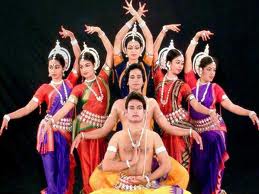
Odissi Dance :
Odissi dance is the typical classical dance form of Odisha and has its origin in the temples.
The rhythm, the bhangis and mudras used in Odissi dance have a distinctive quality of their own.
Odissi dance deals largely with the love theme of Radha and Krishna.
It is a lyrical form of dance with its subtelety as its keynote.
The intimate relationship experienced between the poetry and music in Odissi is a feature on which the aesthetics of the style is built.
Odissi bases itself on a wealth of systematized techniques which make this dance aesthetically appealing and visually delightful.
It is a “sculpturesque” style of dance with a harmony of line and movement, all its own.
What is interesting about Odissi is that body position is not merely a part of the vocabulary or frame-work.
The posture by itself conveys a particular mood or message. The names of these postures too express the moods they represent.
The different items of the Odissi dance style are Managlacharna, Batunrya or Sthayi Nata, Pallavi, Abhinaya and Moksha.
In mangalacharana the dancer dedicates herself to the Lord and begs forgiveness of the Mother Earth for stamping her feet upon her; she apologises to her audience for any shortcomings and offers salutations to the Guru. Batu Nrytya is pure dance.
It begins with a series of sculpturesque poses symbolising the playing of the veena, drum, flute or cymbals. Pallivi is extremely graceful and lyrical.
The tune is in some raga and is sung to the accompaniment of Sargam and Bols.
Through facial expressions abhinaya depicts rasa and bhava to bring out the meaning and mood of songs.
Generally the songs written by poets, Banamali, Upendra Bhanja, Baladeva Rath, Gopala and Jayadeva are sung.
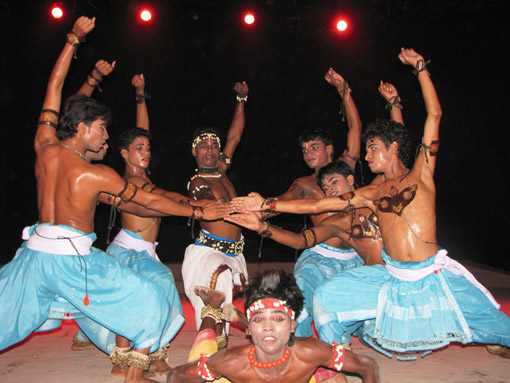
Chhau Dance :
Chhau is an ancient dance form. It originated in the mock fights of the Oriya paikas (warriors) who fought rhythmically to the accompaniment of indigenous music instruments.
The highly Stylised Chhau dance of today follow the basic principle of the Natya Shastra of Bharat Muni and the Abhinaya Darpana of Nandikeswara.
This dance form became closely associated with religion. The Chhau dancers worship Lord Shiva and Goddess Parvati, the two presiding deities of the Tandava and the Lasya styles respectively.
The typical Chhau dance pose when the dancer at rest is the bent knee so that the legs form a Square, the raising of the, right hand upward with the left hand handing downward both forming right angles the elbow.
The Chhau dancers have to practices difficult modes of walk-in, striking difficult postures and moving in a way peculiar to this style.
It is a virile dance form and was in the past undertaken by male dancers who performed in female roles, as and when required.
Today there are also female dancers who have master this art. The face is generally covered with .the mask of the character who being depicted by the dancer in the Saraikala School of Chhau dance.
But in the Mayurbhanj school, the face is left uncovered: Emotions and passions are not depicted by facial expression but by intricate footwork, whirls and jumps. Hence, the wait the feet and the legs are used to depict bhavas.
The dance is usually performed in the open air on a raised platform, the musicians stand, on one side of the platform and play on big kettle drums and other musical instruments. In villages, Chhau dance is usually performed during Chaitra parva festival in the days concluding the month of Chaitra.
Popular story from the Ramavyna and Mahabharata are staged. The costumes, the headgear and other ornamental requisites are carefully selected.,
The dance programme consists of solo, duet or Group, performances.
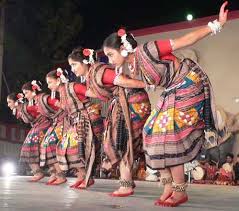
Dalkhai Dance :
Though Dusserah is the occasion of Sambalpuri folk dance Dalkhai, it’s the most popular folk-dance of Orissa,
its performance is very common on all other festivals such as Bhaijiuntia, Phagun Puni, Nuakhai, etc.
This is mostly danced by young women of Binjhal, Kuda, Mirdha, Sama and some other tribes of Sambalpur, Balangir, Sundargarh, Bargarh, Nuapada and Kalahandi districts.
During this dance men join them as drummers and musicians. The dance is accompanied by a rich orchestra of folk music played by a number of instruments known as Dhol, Nisan, Tamki, Tasa and Mahuri.
At the beginning of the performance, the Dhulia (drummer) beats the Dhol (drums) and young girls stand in line and sing songs, which are called Dalkhai songs. The girls sing for a while and then start dancing by bending forward to half sitting position.
Different movements of their hands, legs, knees, hips are given primary importance.
During the dance the girls place a piece of Sonepuri Ganga Jamuna Gamuchha (cloth), of red or pink colour, on their shoulders.
While dancing they move their hands forward and backward alternately. The dancers regulate their steps according to the sound of the dhol, i.e.,
sometimes slow and sometimes fast.
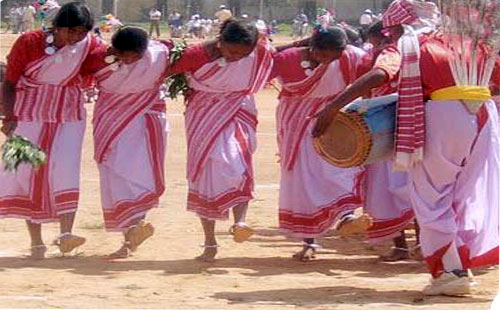
Karma Naach (Karma Dance of Odisha) :
Karam or Karma literally means ‘fate’ in Kosli Oriya.
This pastoral Sambalpuri folk dance is performed during the worship of the god or goddess of fate (Karam Devta or Karamsani Devi), whom the people consider the cause of good and bad fortune.
It begins from Bhadra Shukla Ekadasi (eleventh day of the brightmoon of the month of Bhadra) and lasts for several days.
This is popular among the scheduled class tribes (e.g., the Binjhal, Kharia, Kisan and Kol tribes) in the districts of Balangir, Kalahandi, Sundargarh, Sambalpur and Mayurbhanj.
This dance is in honour of Karamsani, the deity who bestows children and good crops.
After the puja is done it is followed by singing and dancing in accompaniment of drum (maandal), cymbal etc.
The dance performance full of vigour and energy combined with charm of the youth decked with colourful costumes in exuberance of red cloth, set in peacock feathers, skillfully designed ornaments made of small conch shells, brings the onlookers as well as the performers to a mood of trance and ecstasy.
In this dance both men and women take part and continue to engross themselves for the whole night.
The skillful movement of the young boys with mirror in hand indicates the traditional pattern of love-making in course of dancing and singing.
The dance is performed sometimes by boys in group, sometimes by girls in group and sometimes both the sexes together.
The subject matter of songs constitutes the description of nature, invocation to Karmasani, desires, aspiration of people, love and humour.
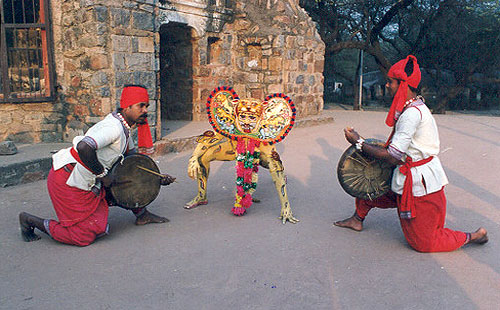
Bagha Naacha or Tiger Dance of Odisha :
Odisha is a beautiful state with many well versed and cultured people.
The residents of this region are also too creative and dancers.
They know various kinds of dance forms and are well versed in it.
Odisha is also popular for its folk dances in various other states of India.
Baagh Naach is one another folk dance form which is also widely enjoyed by many people of Odisha.
Moreover this Baagh Naach is even known by another name known as Tiger dance.
Also this dance asks for vigorous movements and steps and even is carried out by professional dancers only.
Majority of the locals celebrate various kinds of religious and traditional festivals and events.
Therefore dancers of Baagh Naach perform this dance form on various festivals or events or even on some special occasions.
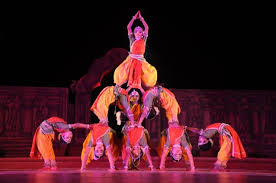
Gotipua Dance :
In Oriya language, “Goti” means “single” and “Pua” means “boy”. For centuries, the Gotipua dance has been performed in Orissa by young boys who dress up as female to praise Lord Jagannath and Lord Krishna. The actual form of the dance is executed by a group of boys who perform acrobatic figures inspired by the life of Radha & Krishna. The boys start to learn the dance at an early age until the adolescence, when their androgynous look is fading.
Costume and Make-up
To transform into graceful feminine dancers, the boys do not cut their hair to make an elaborate hair-do in a knot.
Garlands of flowers are woven into the hair. They apply make-up on their face with white and red powder mixed together.
Kajal (black eyeliner) is applied around the eyes with a broad outline to give them an elongated look.
The Bindi (red dot) is applied on the forehead with a pattern made from sandalwood around it.
Traditional paintings adorn the face and are the identity of every dance school.
The dance costume has evolved over time. The traditional dress is a “Kanchula”, bright coloured blouse with shiny
embellishment. An apron-like and embroidered silk cloth is tied around the waist like a frill worn around the legs:
it is called “nibibandha”. The gotipua dancers have given up their traditional costume due to the influence of modernity.
In some cases, they still adhere to the tradition: they use the pattasari made with one piece of tissue around four meters long,
which is worn tightly by having equal lengths of material on both sides, and by tying a knot on the navel.
Those traditional dresses are often replaced by a new designed cloth easier for dressing.
The dancers wear specially designed jewelry made with beads: necklaces, bracelets, armbands and ear ornaments.
The nose piercing jewelry has been replaced nowadays by a painted motive.
They add ankle bells to accentuate the beats tapped out by the feet.
Palms and soles are painted with a red liquid called “Alta”. The costume, jewelry and bells are sacred items.
History of the Gotipua Dance
In ancient times, the temples of Orissa had female dancers called “Devadasi or Mahari (in Odisha)” who were devoted to Lord Jagannath.
The sculptures of the dancers on the bas-reliefs of the famous temples of Orissa (the Sun Temple in Konark and the Jagannath temple in Puri),
show the evidence of this very ancient tradition.

Ghumura Dance :
Ghumura Dance (or Ghumra Dance) is one of the most leading folk dance form Kalahandi district of Odisha.
It is classified as folk dance as the dress code of Ghumura resembles more like a tribal dance, but recent researchers argue different mudra and dance form present in Ghumura bear more resemblance with other classical dance form of India.
The timeline of Ghumura dance is not clear. Many researchers claim it was a War dance in ancient India and used by Ravana in Ramayana.
Ghumura dance is depicted in Sun Temple of Konark confirming this dance form is since the medieval period.
In the ‘Madhya Parba” of “Sarala Mhabharata” Ghumura has been mentioned as:
Dhola Madala Gadi je Ghumura Bajai Ghumura je Ghumu Ghumu Hoi Garajai
The typical mixed sound that comes out of the musical instruments like Ghumura, Nishan, Dhol, Taal, Madal etc. and
the expressions and movements of the artists make this dance to be a “Heroic Dance”.
Since thousands of years Ghumura dance has evolved from a war dance to a dance form for cultural and social activities.
The dance is associated with social entertainment, relaxation, love, devotion and friendly brotherhood among all class, creed and religion in the present days.
Traditionally this dance is also associated with Nuakhai and Dasahara celebration in Kalahandi and large parts of South Western Orissa.
Ghumura dance is still hidden in the village level in South Western Orissa and some parts of bordering Andhra Pradesh and Chhattisgarh.
Kalahandi region has taken a leading rule in popularizing and retaining its unique identity of Ghumura dance. Kalahandi is mainly known as land of Ghumura.
Ghumura dance has got the opportunity to represent the nation in various international events Delhi, Moscow, Kolkata, and various other cities in India.
Ghumura dance is also one of the most researched folk dance form in Odisha.
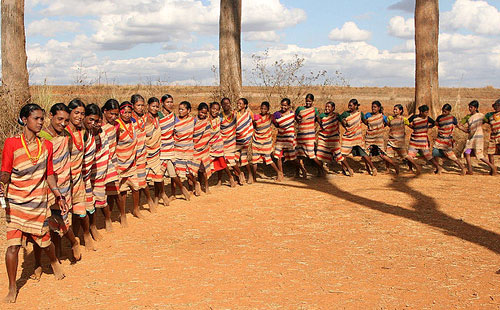
Tribal Dance :
The Tribals who constitute about one fourth of the total population of Odisha have very many dances of secular, religious and seasonal in character.
Living in the midst of nature their dances and songs are vivid, temperamental and attuned to nature herself.
Nature is always the strongest inspiration for them, coupled with the customs and religious heritage.
The colourful spring time dance of the ‘Santals’ with their musical instrument, ‘Madal’ performed by the maidens,
their pastoral dance during ripening of grain,
the dance of the ‘Kolha’ at the time of planting of the seeds in honour of their deity is performed by men and women.
The dances of the Gonds done in dedication to their deity ‘Bhimsen’ at harvesting festival time, marriage celebrations accompanied
by several musical instruments like the horned-drums,
flutes and many clarions.
The spring dance of the ‘Bhattara’ with beautiful dresses, silver ornaments of women, flushed as they move and
the colourful turbans of the men stuck with peacock feathers.
The ‘Sua’ dance of the Sambalpur tribes performed by the young girls in the spirit of adventure and romance accompanied by drummers and musicians.
The ring dance of the ‘Oron’ performed during all festivals and in the spring and autumn seasons in a circle.
The women dancers placing their arms at the back of their neighbours and clasping the hands of the next, the courtship dances of ‘Ho’.
The ‘Jhadia Paraja’ dance exhibiting graceful movement and artistic skill, the colourful dance of the ‘Gadaba’, the dance of the
‘Koya’s with the headdress of Bison horn.
Women dressed in colourful attires with iron sticks in hands making a jingling sound in accompaniment of musical instruments.
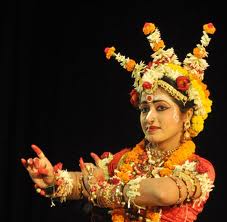
Mahari Dance :
Mahari Tradition of the Sri Mandira is the beautiful Parijata flower of art an history of Utkal.
It also makes living by its fragrance and the touch of nationl. It has been doing so far from the time immoral.
It has made the art of Utkala glorious Mahari tradition is the same and one union of Lord Jagannath and great Nari Mahari.
Mahari Dance coming from the Nata temple of the temple has reached and extended to the stage and shastriya Odissi dance art.
Now a days common man having seen the round eye of Lord Jagannath l has become wholeness of Karatali under
this remains purity action whollyness of Mahari. It is a prensial emotion of life and heart and sloving.
Amongst all who made this mahari dance living and has given to the people in general for publicity and
its pride Guru Pankaja Charana Das comes to the foremast rank.
He has made the dream ‘fruitful’ . This Mahari awarded is opened for all who take it as a tradition witrh whole heartedness.
Now Odissi has climbed the pick lof culture everelst of the world but the proponents of this art ,
that is the Mahari are numbered and along with them will go this age old tradition of Odisha.
We all specially the Oriyas should not forget the contributions made by this great lordies.
|